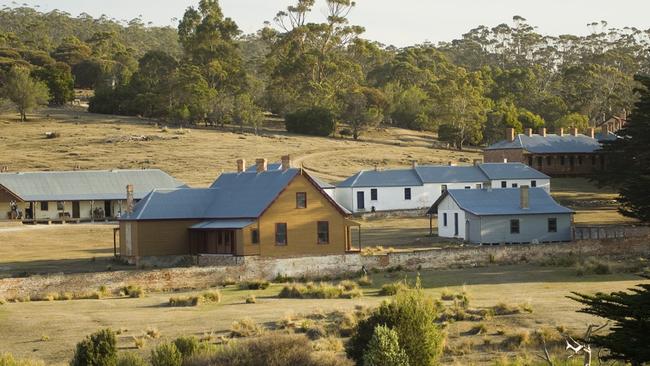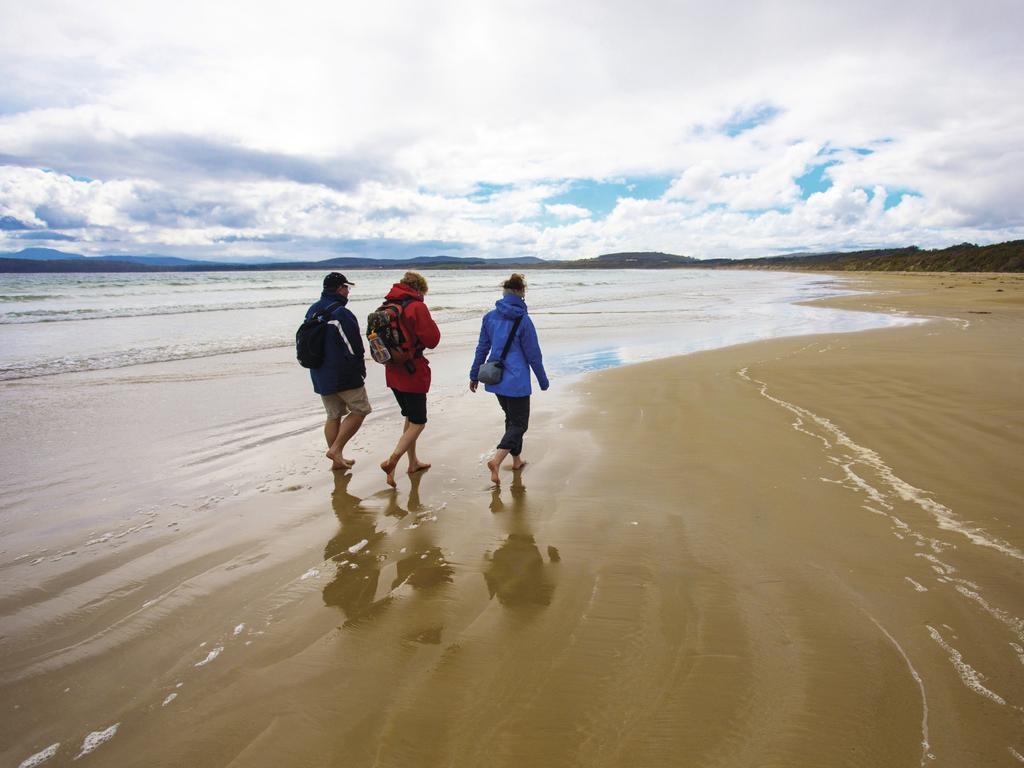Something about Maria Island
Barefoot delights await walkers on this history-packed isle 40 minutes off Tasmania’s east coast.

This is no ordinary bushwalk. The first steps are barefoot and calf-deep in seawater as we make our way from boat to beach. Wiggling toes in the pale, pristine sand, I gaze along the shore of glittering Shoal Bay, which is lapped by little waves. There is an immediate connection with wild, remote Maria Island, an expanse of nearly 10,000ha that has been national park since 1971.
At the suggestion of guides Nat Poros and Pete Attard, our group continues barefoot. Initially it seems odd walking boot-free with a biggish backpack, but the wet sand feels good and supports our weight. As Poros explains, keeping close to the water’s edge also means we won’t disturb the almost invisible nests of hooded plovers.
We spot these shy shorebirds among grasses high up the beach, and their bolder cousins, long-legged oystercatchers, hunting by the water. We see exquisite shells and strange sea-snail egg sacks, like crescents of clear jelly, before crossing – still barefoot – a narrow isthmus, walking beside the wilder waves of Riedle Bay and into the first night’s camp.
Celebrating its 20th anniversary this year, the Maria Island Walk was founded by civil engineer Ian Johnstone, a pioneer of nature-based tourism on the Apple Isle’s east coast and a driver of the Great Walks of Tasmania collection. The Maria experience is now owned by Experience Co and operated by Wild Bush Luxury, which also runs Arkaba Conservancy in South Australia’s Flinders Ranges and Bamurru Plains in the Northern Territory.
But Johnstone’s vision has prevailed and is evident from early this morning in Hobart, when, during the transfer from hotel to the operator’s HQ, our driver briefly stops at a waterfront fishmonger to collect fresh seafood (scallops for tonight’s saffron risotto, as we later discover).
Gearing up and briefed for this four-day experience, we are driven 85km from Hobart to Triabunna on Tasmania’s east coast, where we board the charter boat. The sense of adventure grows on the 40-minute jaunt to Maria, especially as I take up the option of a sea-spray shower at the back of the vessel.
The walk offers nature unlimited as well as comforts otherwise hard to find on this island off an island off an island. With everything from food and wine to bedding provided, the maximum 10 hikers need to carry only personal essentials such as clothes and water between each night’s private accommodation.

First up is Casuarina Camp, named for the surrounding trees, also known as she-oaks. Boardwalks lead to semi-permanent structures, including safari-style two-person tents, bush showers (with hot water) and composting loos (not stinky drop toilets; layers of wood shavings mean they smell surprisingly pleasant). These structures are conveniently clustered but far enough apart that they seem to have sprung from the shady bracken-fern meadow.
Post-lunch, most of us don daypacks for the optional walk to the island’s southern coast. Eventually the sapphire blue of Haunted Bay appears between tall eucalypts and, after a challenging descent between boulders, we rest on massive slabs of pink granite to enjoy a tri-colour clifftop panorama of vivid orange lichen, white water crashing on to the rocks below and shades of blue stretching to the distant Tasman Peninsula.
It’s been a sweaty day, so after returning to camp I stroll across to the nearby beach to give my body a pounding in the waves. Nature’s invigorating spa treatment is followed by fine Tasmanian cheese, cold beer and wine before a candlelit three-course dinner. Wild bush luxury indeed.
Our tireless, multi-talented guides prepare different meals every day. There’s a barbecue dinner of quail, kangaroo sausages and lamb cutlets, and a ploughman’s lunch featuring fluffy focaccia handmade by Poros. Excellent wines are from Tasmania’s east coast and Coal River Valley regions.
On day two, on our way to White Gums Camp, we get a glimpse of the island’s convict past at the red-brick ruins of a Darlington Probation Station outpost, as well as some 20th-century history at the former homestead and shearing shed of Frenchs Farm. Another highlight is Bloodstone Point, where seaside rocks resemble big blobs of the red stuff that have darkened, hardened and eroded over millennia.
Day three will eventually take us to a smudge of civilisation on the island’s north coast. Darlington was established as a convict settlement in 1825 and abandoned seven years later before the British returned in 1842 for another short-lived attempt at making crime pay by putting prisoners to work. Now a World Heritage site, it has several well-preserved buildings from the period.

The next day dawns wet, putting the optional long hike inland to Mount Maria’s summit off limits, but no matter as the mostly coastal walk to Darlington is scattered with memorable moments. It begins barefoot on the beach once again for a creek crossing, takes in a 19th-century quarry, and the all-natural Painted Cliffs. The tide is too high and sky too grey for a good look at this geological work of art’s swirling strata of cream and ochre-hued limestone. Instead, Attard offers a sideshow, inviting us to gather closely around the sea snail he holds, and to hum in unison. I’m convinced his promise that sustained humming will make the snail peep out of its shell is good-natured carnival showmanship … right up until the moment it does.
There are many other wildlife surprises today, including grazing wombats, macropods such as Tasmania’s petite pademelons, and Cape Barren geese. The island has no permanent residents, but the closer we get to Darlington, where the passenger ferry docks, the more encounters we have with other visitors.
We arrive at the third night’s accommodation, which represents another phase of Maria Island’s history. It’s the 1880 home of Italian entrepreneur Diego Bernacchi, who tried everything from cement works to the deceptively named Coffee Palace to make his fortune here. He failed, but these structures remain as part of Darlington’s heritage.


With a focus on local artisans and materials, Bernacchi House’s recent makeover has included sandstone side tables and soft furnishings of earthy-coloured natural fibres. I’m tempted to kick back amid its comforts, but choose the walk to the twin peaks called Bishop and Clerk.
Despite days of hiking, this 11km-return, grade-four trail is no walk in the park, and a reward of summit vistas is unlikely as the mountain is shrouded in cloud when we start. Up we go through grasslands, bush and a pocket of rainforest, followed by a steep slope of unforgiving rocks. Wiping sweat from my brow, I wonder if sipping chilled Tassie riesling on Signore Bernacchi’s porch would have been the better option.
At some point the clouds clear, so at the top of Clerk we are unexpectedly rewarded with views from Maria’s north coast. This perfect blue-sky afternoon reveals an epic panorama unfolding from dolerite columns of Bishop opposite, down across the island, over the sea to Freycinet Peninsula, and onwards to the horizon. It’s yet another extraordinary moment on a multi-day walk like no other.
in the know
The four-day Maria Island Walk is available October-April for $2890 a person, twin-share, or $5030 single occupancy. The three-day Winter Escape Walk, with accommodation at Bernacchi House only, is offered June-August for $1790 or $3115 single occupancy. Both tours include return transfers from Hobart, meals and beverages, including alcohol, and optional loan of essential equipment such as 50-litre backpacks. Pack-free options are available
Patricia Maunder was a guest of Wild Bush Luxury.





To join the conversation, please log in. Don't have an account? Register
Join the conversation, you are commenting as Logout